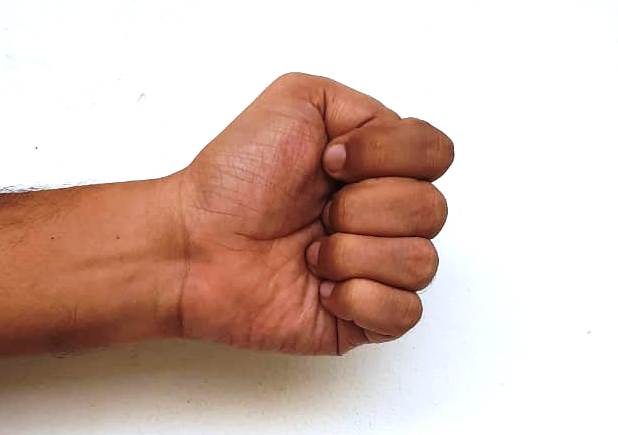Adi Mudra – Meaning, Method Of Doing, Benefits, Dosha Effect
By Dr Raghuram Y.S. MD (Ay) & Dr Manasa, B.A.M.S
Adi mudra is hand gesture. It is called the first gesture because it is the first position the hands of the fetus are capable of making inside the womb of the mother. It is used in the spiritual yoga practice to calm and quiet the mind and nervous system. It is often used in the practice of meditation. It helps prepare the practitioner for pranayama breathing exercises. This mudra focuses on breathing patterns and your internal chest structure. It may also be practiced in the asanas.
Read – How To Do Pranayama – A Simple Pranayama Technique
Adi = first / primal
Mudra = gesture / mark / seal / pose

Table of Contents
Procedure
- Sit in any comfortable position. Prefer sitting in yoga meditation poses. One among the Sukhasana i.e. easy pose, Padmasana i.e. lotus pose or Vajrasana i.e. diamond pose.
- Sit on a mat and not on the floor.
- Keep your spine erect.
- Close your eyes so that you can focus on the gesture.
- Breathe easily and focus your concentration on the breathing pattern.
- Keep your hands on your thighs or knees with palms facing down
- Press your thumb on the inside of the palm. The fingers are closed around the thumb so as to make a gentle fist. Do this in both hands simultaneously.
- Now concentrate on your breathing patterns. Keep the breathing ratio at 4:3:6:3. This means – inhale 4 times. Keep the air inside for a count of 3. Now exhale 6 times. While keeping your belly empty and without air count 3.
- Repeat the entire cycle for 7 times.
Read – Yogasana – Spiritual, Physical And Mental Benefits, Classification
Release –
- Release your fingers from the fist formation.
- Bring your hands back to your thighs or knees and rest them.
- Breathe freely and relax.
Related Video – Adi – Hand Mudra – how to do
Time and Duration
- The gesture shall be practiced for 30 minutes at a stretch or 10 minutes at a time for three times a day.
- It should preferably be practiced at the early morning time and on empty stomach for obtaining better benefits.
- It shall be practiced in a quiet setting while meditating and focusing on the breath.
Read – Mudra – The Science Of Gesture: Benefits, Types, How To Practice
Benefits
- Increases the capacity of lungs and strengthens them
- Enhances oxygen flow in the body
- Helps your vital organs to functions effectively
- Calms your nervous system, stimulates the brain which is close to the crown or sahasrara chakra
- Stimulates and motivates the sensory system
- Keeps one alert by enhancing mental activeness
- It can help in achieving balance in some of the balancing postures like tree pose
- Enhances the sense of peace and promotes the awareness and connection with self
- It can be very useful in shavasana at the end of asana practice. This quiets the nervous system.
Effect on the chakras
This gesture governs, controls, energizes and balances the crown chakra i.e. sahasrara chakra that governs an individual’s sense of peace, higher awareness and oneness with the universe.
Read – Chakra – Kundalini: Introduction, Meaning, Types, Location, Ayurveda View
Impact on the doshas
It stimulates udana vayu, the governing vayu for the upper chest, throat and head. It calms and balances the prana vayu and maintains the prana vayu- udana vayu axis.
Click to Consult Dr Raghuram Y.S. MD (Ayu) – Skype








10 comments
Mahesh Appu
It says this Mudra is done palms facing down.
Just want to reconfirm if its palm facing down or palms facing up. Or can it be done either ways
Please advise. Regards Mahesh
Dr J V Hebbar MD(Ayu)Author
It can be done either ways.
N. Balasubramanyam
Some websites have suggested against practising the Adi mudra for those having hypertension.
What is your advise.
Dr J V Hebbar MD(Ayu)Author
It does not cause increase of blood pressure.
subramanian
does the adhi mudra good for copd and heart patients ? Does it cure copd and heart problems?
Dr J V Hebbar MD(Ayu)Author
It is useful in COPD patients. It does not cure COPD or heart prolems.
Ramkishore Singh Rathore
Does Adi mudra promotes clavicular breathing?
Dr J V Hebbar MD(Ayu)Author
Yes.
G.VENKATA SESHAIAH
Sir,
WILL ADI MUDRA INCREASES “”BELLY FAT?””
Dr J V Hebbar MD(Ayu)Author
No.